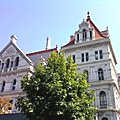- By Dan Veaner
- News
 Print
Print  The percentage of school districts initially planning to override New York's property tax cap in 2016-17 has nearly doubled when compared to last year, but still remains relatively small, according to preliminary data filed with the office of State Comptroller Thomas P. DiNapoli. As of March 2nd, 6 percent, or 36, of the 601 school districts that reported, indicated that they will seek an override of the tax cap. Last year, 3.5 percent, indicated plans to override the tax cap.
The percentage of school districts initially planning to override New York's property tax cap in 2016-17 has nearly doubled when compared to last year, but still remains relatively small, according to preliminary data filed with the office of State Comptroller Thomas P. DiNapoli. As of March 2nd, 6 percent, or 36, of the 601 school districts that reported, indicated that they will seek an override of the tax cap. Last year, 3.5 percent, indicated plans to override the tax cap.Property tax levy growth for school districts is capped at 0.12 percent above current levels for the 2016-17 fiscal year.
"School districts are feeling the impact of a historically low tax levy limit," said DiNapoli. "Although district administrators and school boards have been reluctant to exceed the tax cap, this year's limit seems to have left some districts with limited options. As school budget planning continues over the next few weeks, we may see additional districts deciding to seek voter approval for an override."
The tax cap, which first applied to local governments beginning in 2012, limits tax levy increases to the lesser of the rate of inflation or 2 percent with certain exceptions, including a provision that allows school districts to override the cap with 60 percent voter approval of their budget.
For the 601 school districts that have filed their tax cap reports, initial calculations using the state's school tax cap formula show they will be able to levy a total of $19.4 billion in 2016-17. This represents a 0.89 percent increase over the $19.2 billion they levied during the current 2015-16 school year.
Certain unique aspects of the school tax cap formula, such as the capital levy exclusion, make schools more susceptible to major swings in their allowable levy limit from one year to the next. For example, there are some districts whose 2016-17 tax levy limit will drop from what was levied in 2015-16.
According to initial reports, nearly 13 percent of school districts (76 of 601 districts reporting) are facing a "negative" levy limit. These districts would need to cut taxes by a total of $18.6 million (1 percent on average) to stay within their allowable levy limit, or seek an override in order to maintain the same tax levy.
To date, 20 districts, or 26 percent of those in the "negative" levy limit situation have indicated that they plan to seek an override of the tax cap in 2016-17.
School budgets head to voters for approval on Tuesday, May 17. Since it is still early in both the school budget and state budget processes, districts can still modify their submissions to the Comptroller. Of the 677 school districts required to report, 76 have not yet filed.
For 2016-17, DiNapoli's office previously estimated the state's school districts (excluding New York City and the Big Four city school districts) will have about $308 million less in levy growth compared to what they had in 2015-16 when the allowable growth factor was 1.62 percent.
v12i9



